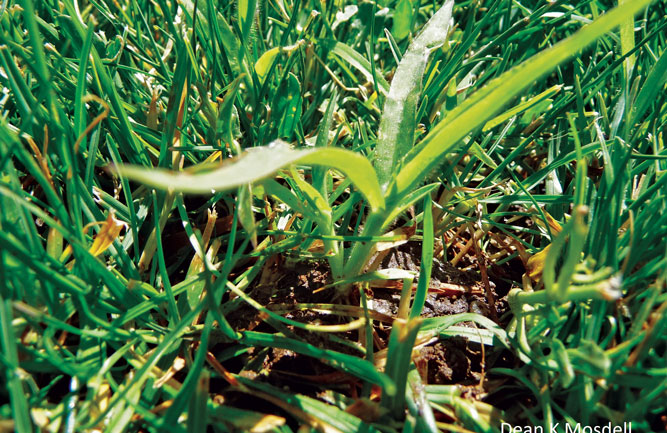A Q&A with Matt Elmore: Goosegrass in the mid-Atlantic
Matt Elmore, Ph.D., is a turfgrass weed scientist at Rutgers University. Matt and his team have an extensive weed science research program, and they place an emphasis on understanding goosegrass and its control. You may reach Matt at matthew.elmore@rutgers.edu for more information.
Q: Explain a little about the life cycle of goosegrass.
In central New Jersey, goosegrass germinates in early May, which is two to four weeks after crabgrass germinates. Our monitoring has shown that goosegrass seed will first germinate when the soil temperature at a 2-inch depth reaches a daily maximum of 75 degrees F. A big flush of goosegrass germination occurs when the soil temperature at a 2-inch depth reaches a daily maximum of 85 degrees F.
We have observed large flushes of goosegrass seed germination in mid-to-late August if the turf thins out. It takes about two months of good growing weather for goosegrass to produce seed, and it’s a prolific seed producer.
Goosegrass emergence patterns differ from golf course to golf course. We believe there are a number of goosegrass biotypes that lead to variability in emergence and other characteristics.
Q: Why is goosegrass becoming more of a problem in your area?
I’m not really sure, but several factors may play a role in goosegrass becoming more of a problem. The duration and intensity of high temperatures in summer have increased, which causes more stress on the cool-season turf and provides good growing conditions for warm-season weeds like goosegrass. Herbicide use patterns have changed. For instance, MSMA is no longer used as a postemergence control for goosegrass, and perhaps more goosegrass now survives to produce seed. And it’s possible that goosegrass has developed resistance to commonly used preemergence herbicides that are primarily applied for crabgrass control, such as dithiopyr, pendimethalin and prodiamine.
Q: How widespread is herbicide-resistant goosegrass, and how does it develop?
In our area, we are uncertain of the extent of herbicide-resistant goosegrass and are working to identify and document cases of it. Herbicide-resistant goosegrass develops from long-term repeated use of herbicides with the same mode of action. Dithiopyr, pendimethalin and prodiamine all have the same mode of action. Long-term continuous use of any one herbicide or some rotation of all three can lead to the development of herbicide-resistant goosegrass. Oxadiazon (Ronstar) has a different mode of action than dithiopyr, pendimethalin and prodiamine and can be used for preemergence control of goosegrass.
Rely on cultural practices to produce a healthy, dense stand of turf and don’t be afraid to aerate highly trafficked areas, even if you have applied a preemergence herbicide. This is the best goosegrass control strategy.
Q: Describe a preemergence herbicide strategy for controlling both crabgrass and goosegrass.
On many golf courses in our area, it’s common to find both crabgrass and goosegrass. Keep in mind that dithiopyr, pendimethalin and prodiamine are more effective on crabgrass than goosegrass, and oxadiazon is more effective on goosegrass than crabgrass.
To target crabgrass, apply dithiopyr, pendimethalin or prodiamine prior to crabgrass seed germination. Dithiopyr applications also offer early postemergence crabgrass control. To target goosegrass, apply oxadiazon three to four weeks after crabgrass seed germinates.
If a superintendent is using oxadiazon for the first time, start in year one by applying it to the most problematic areas to get comfortable with the herbicide. Be sure to use the granular formulation on cool-season grasses and apply it to dry turf.
Q: Is there anything else you would like to add?
Focus on improving turfgrass density. If you plan to use a postemergence herbicide to control emerged goosegrass, be sure to treat the goosegrass prior to tillering. Large, tillered goosegrass is difficult to control, especially in creeping bentgrass where herbicide use rates are limited. After using a postemergence herbicide to control goosegrass in midsummer, consider applying a product that contains oxadiazon to prevent additional goosegrass seed from germinating, unless you plan to seed in the fall.












